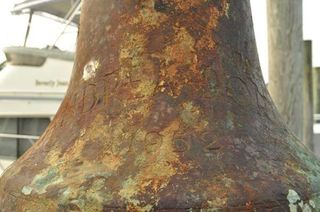
Bell from Famed Wreck of Andrea Doria Discovered

A group of divers has unexpectedly found the bridge bell of the SS Andrea Doria, an Italian ocean liner that famously sunk off the coast of Nantucket, Massachusetts in 1956.
The divers, Ernest Rookey and Carl Bayer, came upon the 75-pound bronze bell June 25 at the wreck site some 240 feet (73 meters) below the ocean surface. The pair was about 18 minutes into what was supposed to be a 20-minute dive when Bayer spotted "the very distinctive shape of [the bell] sticking up out of the sand," said Joel Silverstein, the leader of the diving expedition to the wreck.
In just three or four minutes, divers were able to raise the bell to the surface with an inflatable balloon-like device. Then they got a better look at the bell, weathered by decades on the ocean floor, and rang it for the first time since the ship sank.
The discovery of the bell, first reported by The Star-Ledger, is one of the major discoveries from the famed shipwreck, which has been explored by divers since it sank.
"It's a great find," Silverstein said.
Andrea Doria goes down
The SS Andrea Doria was one of several ships in the Italian Line. On July 25, 1956, the 637-foot, 29,100-ton ship was sailing through an area off Nantucket known as Times Square (because of all the ship traffic passing through).
Sign up for the Live Science daily newsletter now
Get the world’s most fascinating discoveries delivered straight to your inbox.
The area is often shrouded in fog — as it was that day — created by the collision of warm currents from the Gulf Stream with the cold waters of the North Atlantic. That fog could make it difficult to see other ships in the area.
At the same time the Andrea Doria was headed towards New York through the shipping corridor, the MS Stockholm, a small passenger liner, was sailing through the same area coming from New York.
A misinterpretation by each ship of the position of the other boat set the stage for a collision a little after 11 p.m., when the Stockholm gouged a hole in the Andrea Doria. Watertight compartments kept the ship afloat until around 9:45 a.m. the next day. The ship had completely disappeared under the water by 10:09 a.m.
Rescuers were able to save 1,660 passengers and crew, but 46 people died in the accident.
Difficult diving site
The wreckage of the Andrea Doria is one of the most popular and well-known shipwreck sites in the world, along with the Titanic and the Lusitania, Silverstein said.
But while the Titanic and Lusitania are protected by their governments, even though they are in international waters, the Andrea Doria is not protected.
"It's an abandoned shipwreck," said Silverstein, the Vice President and COO of Tech Diving Limited.
The location of the shipwreck also means it is "one of the most difficult dive sites to get to," he told OurAmazingPlanet.
For one thing, depending on where an expedition sets sail from, the site is anywhere from 65 to 95 miles from home port. For another, weather and sea conditions dictate that only about two to three diving expeditions can run in a season, which lasts from the end of June to the first or second week in August, said Silverstein, who has done 14 trips (with 54 total dives) to the wreck over the last 18 years.
In addition, the same fog that helped sink the ship is still an issue today. "The fog that rolled in then still roles in now," Silverstein said.
The diving conditions at the site can also be tricky because different currents meet up around the spot, and surface waters can be flowing a different way from the waters at mid-depth, and the waters at the ocean bottom can be flowing yet a completely different way from either of the other layers.
Silverstein said that he and the divers on the trip that found the bell lucked out. "We actually had some pretty pristine conditions," he said.
Forgotten bell
Divers have explored and brought up many artifacts from the Andrea Doria's wreckage over the years.
Many pieces of china and glass have been brought up from the wreckage. The stern bell of the ship was recovered in 1985, and a 1993 salvage expedition launched by Andrea Doria aficionado and historian John Moyer brought up large ceramic frescoes from the ship that had been used as architectural dividers.
"That was a major significant find and recovery," Silverstein said.
No one had yet found the bridge bell though. "This particular bell was just forgotten about; nobody was looking for it," Silverstein said.
The bells of the ship are particularly exciting finds because they are some of the only parts of the ship that had its name emblazoned on them.
"The bell is a prize," Silverstein said.
The bell now belongs to the divers who found it, Bayer and Rookey, though Silverstein says they have not yet decided what they will do with it. They're "kind of dealing with some shell shock at the moment," he said.
He did say that "they will not sell it," and will likely take it around to several dive exhibitions.
- Titanic: Fact or Fiction
- The First (and Last) Voyage to the Bottom of the Sea
- How Weather Changed History
This article was provided by OurAmazingPlanet, a sister site to LiveScience.

Andrea Thompson is an associate editor at Scientific American, where she covers sustainability, energy and the environment. Prior to that, she was a senior writer covering climate science at Climate Central and a reporter and editor at Live Science, where she primarily covered Earth science and the environment. She holds a graduate degree in science health and environmental reporting from New York University, as well as a bachelor of science and and masters of science in atmospheric chemistry from the Georgia Institute of Technology.
Most Popular

